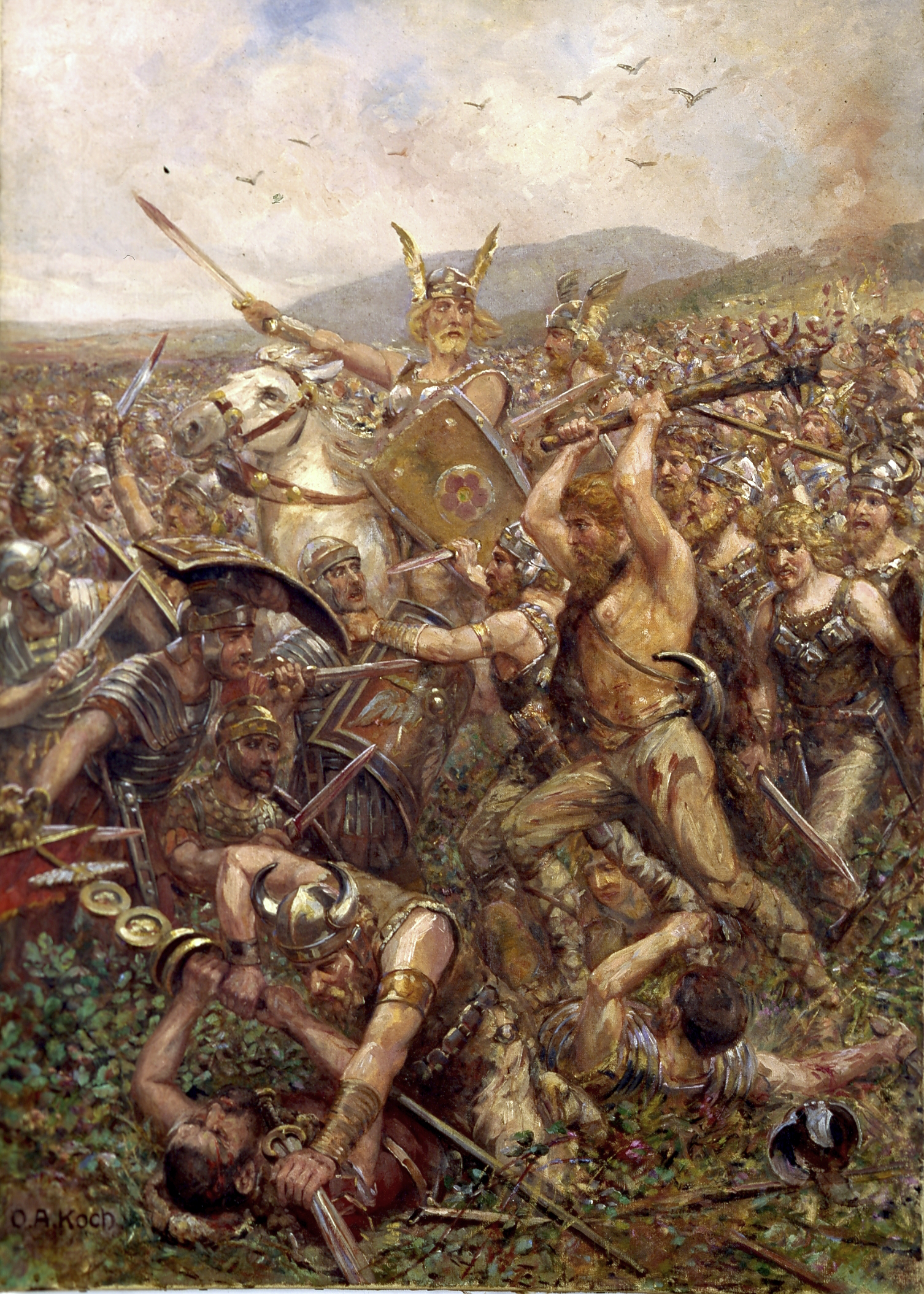When Gaius Suetonius Paulinus, decided to abandon London (Londinium) and re-join his army on its march south-east down Watling Street, his predicament was desperate. But he was an experienced and resourceful general who kept his nerve. His difficulties were compounded by the refusal of the acting commander of Legio Secundae Augusta (The Second Augustan Legion) in Exeter (Isca Dumnoniorum), Poenius Postumus, to join forces with him. Moreover Legio Nonae Hispana (The Ninth Spanish Legion) under Petillius Cerialis had already been badly mauled by the Iceni Celtic Tribe and was immobilised in the east Midlands. The army Suetonius had at his disposal consisted of the whole of Legio Vicesimae Valeria Victrix (The Twentieth Legion, Valiant and Victorious), part of Legio Quattuordecimae Gemina (The Fourteenth ‘Twinned’ Legion) and those auxiliaries he was able to summon from nearby bases, in all a force of some ten thousand men.
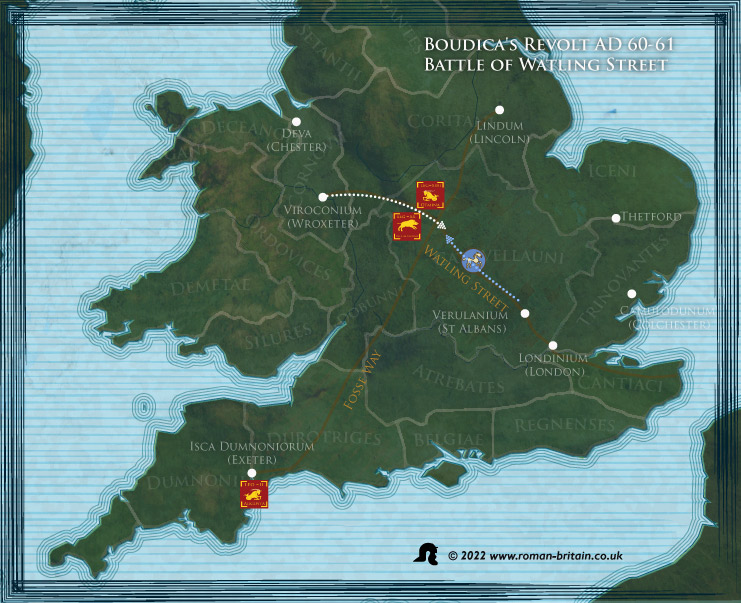
His only hope was that the Boudican hordes would be foolhardy enough to risk a pitched battle. What Suetonius must have feared above all was a protracted guerrilla war with the prospect of surprise attacks in wooded countryside where the Britons could use a knowledge of the terrain to their advantage. But elated by their earlier victories, the Iceni and Trinovantes staked all on one battle.
What troops did Suetonius have?
Suetonius had the legio XIIII Gemina and a vexillatio of legio XX (he probably garrisoned Anglesey-Mona), maybe some 7,000 legionaries in total, and those auxiliaries (rarely named or numbered) he already had with him or was able to summon from nearby forts (let us say six cohortes and two alae), in all a force of some 11,000 men. Here we can make a reasonable guess the auxiliaries included our redoubtable Batavi, for Tacitus says that ‘the Batavi cohorts were moved to Britannia where they added to their laurels’ (4.12.3), that is to say, either during the invasion of Britannia or the rebellion of Boudicca. Anyway, the governor was deprived of some 3,000 legionaries, if not more, and probably additional auxiliaries too. He had dispatched an urgent message summoning legio II Augusta from its garrison base at Exeter (Isca Dumnoniorum), but for some mysterious reason its acting commander, the praefectus castrorum Poenius Postumus, failed to respond and didn’t come at all. As he was third in the chain of command, it seems that both the legatus and tribunus laticlavius were elsewhere at the time, the latter perhaps most significantly being Agricola, who was plausibly on secondment to the governor’s official mobile staff, stratores consulares.
Where was the Battle of Watling Street Located?
The Battle of Watling Street was one the most decisive of struggles of Roman Britain, yet its precise location remains a mystery. Tacitus gives no clues to its whereabouts. The site was probably somewhere along the Roman road now known as Watling Street. The Roman army pressed south-east on its march from Anglesey, while the Britons made their way up Watling Street Midlands towards the approaching Romans.
Suetonius may have paused at High Cross, Leicestershire, on the junction of Watling Street and the Fosse Way, to allow consolidation of his forces. Reinforcements should have come up the Fosse Way from detachments of the XX Legion Valeria Victrix from Usk (Glevum) and Legio II Augusta, based at Exeter.
As for the site of the battle, a case can be made for Mancetter (Manduessedum) in Warwickshire, where the high ground approached to the road gives us terrain that fits the meagre topographical sketch of the battlefield in Tacitus. Other suggestions include Arbury Banks, Hertfordshire, or Church Stowe, Northamptonshire.
Suetonius Chooses the site of the battle
Suetonius was allowed to choose his own ground: Suetonius places his men in a gully, his rear was protected by a wood; the plain before him in which the Britons milled around was open ground where there was no possibility of an ambush.
He chose a position approached by a narrow defile and secured in the rear by a wood, first satisfying himself that there was no trace of an enemy except in his front, and that the plain there was devoid of cover and allowed no suspicion of an ambuscade.
Tacitus: Annals: Book Fourteen: XXXIV Suetonius Paulinus chooses his location for battle.
Deployment of troops at the Battle of Watling Street
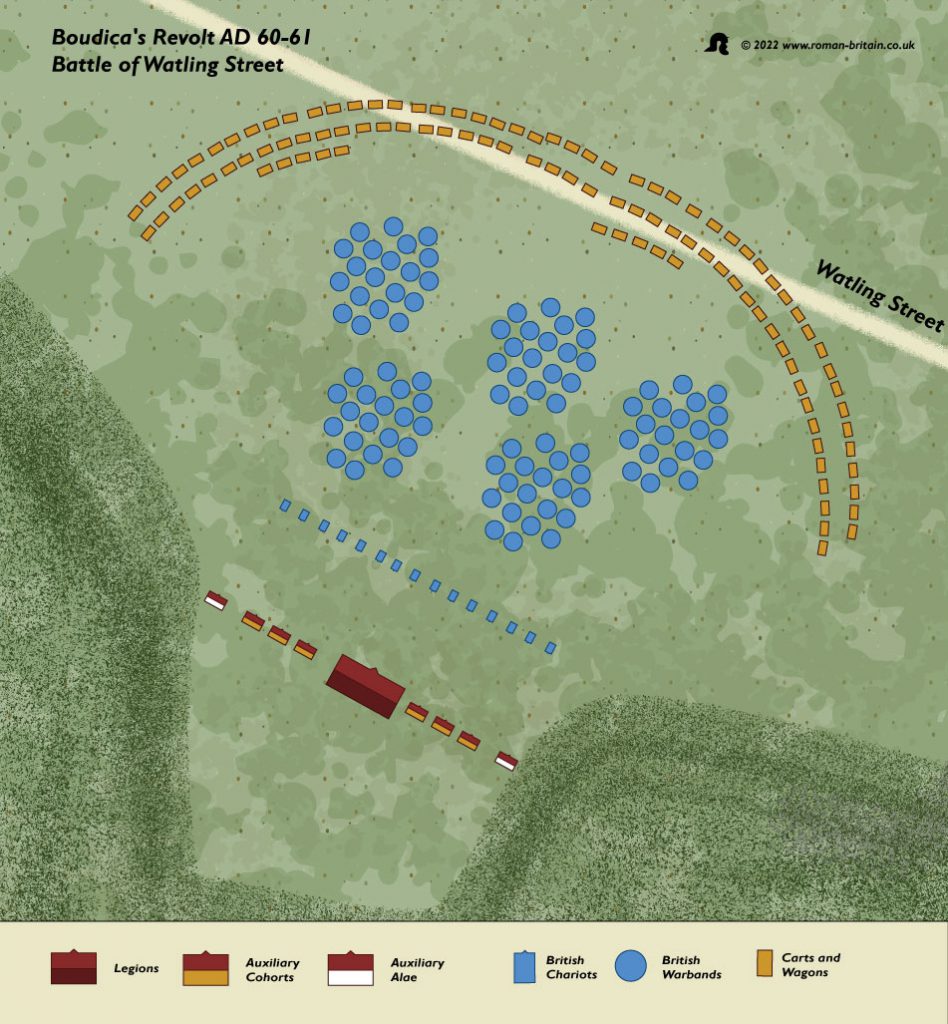
Suetonius’ Deployment
Suetonius placed his legionaries in the centre of his battle line, with auxiliary infantry alongside; the flanks were protected by cavalry.
The legionaries were posted in serried ranks, the light-armed troops on either side, and the cavalry massed on the extreme wings.
Tacitus: Annals: Book Fourteen: XXXIV Suetonius Paulinus chooses his location for battle.
Boudica’s Deployment
Before the battle began Boudica’s generals positioned their baggage train directly behind the army. It’s not known whether or not this was a tactic practiced by certain Germanic tribes such as the Cimbri which used their baggage train as a sort of blocking deterrent preventing retreat or not but it would soon play a major role in the complete destruction of the Britannic coalition army.
The British forces, on the other hand, disposed in bands of foot and horse were moving jubilantly in every direction. They were in unprecedented numbers, and confidence ran so high that they brought even their wives to witness the victory and installed them in waggons, which they had stationed just over the extreme fringe of the plain.
Tacitus: Annals: Book Fourteen: XXXIV Suetonius Paulinus chooses his location for battle.
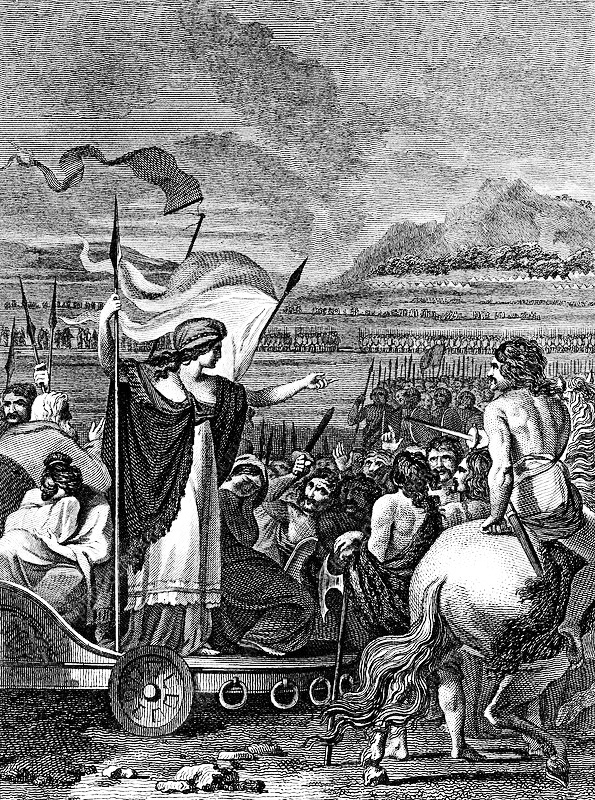
The Battle of Watling Street
As was customary for most of Rome’s tribal based enemies, the Iceni began with a full on charge towards the Roman formation in the wood hollow, expecting their army’s sheer size to break the enemy’s position after which it would be a simple matter of chasing down individual legionaries where they would be promptly dispatched without remorse. Suetonius knew this as did much of his army deployed in the field. He instructed them to hold their ground until the enemy came within range before unleashing at least two volleys of pilum which devastated the front ranks of enemy soldiers killing the momentum of the charge. Amid confusion of the Iceni Suetonius next ordered his infantry to form wedge shaped formations and then signalled a forward advance toward the wounded barbarian formation that had all but halted its charge. The barbarian horde was about to experience the lethal efficiency of the Roman legionary killing machine.
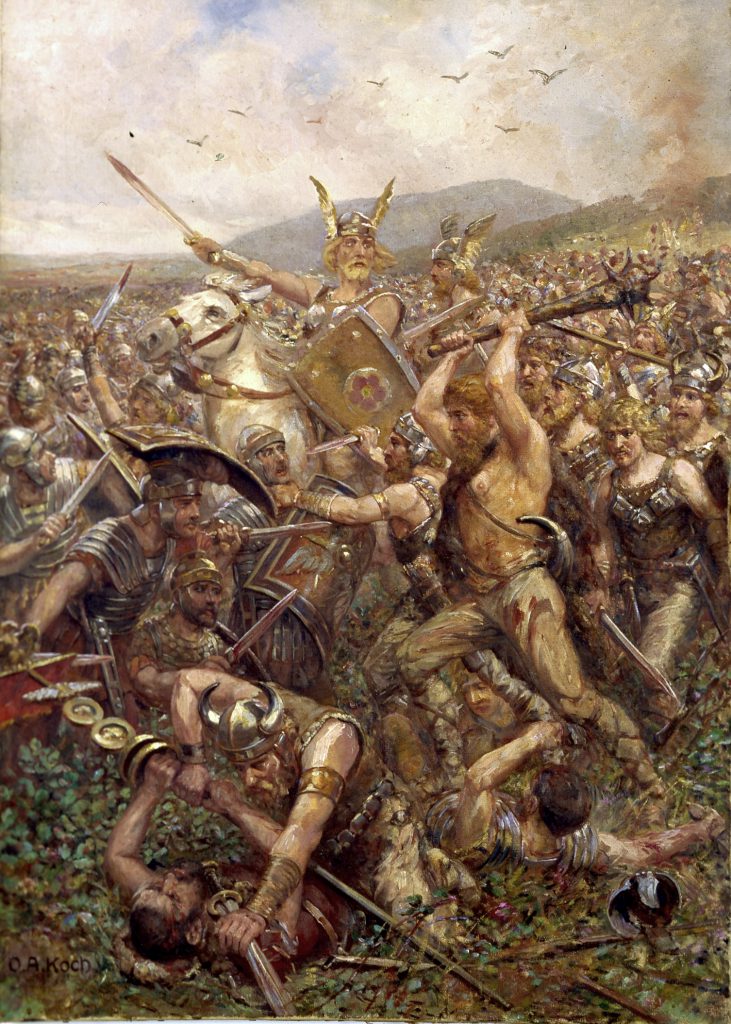
The multi-wedge shaped line of the Romans quickly closed the distance between themselves and the temporarily stunned Britannic tribesmen.
At first, the legionaries stood motionless, keeping to the defile as a natural protection: then, when the closer advance of the enemy had enabled them to exhaust their missiles with certitude of aim, they dashed forward in a wedge-like formation. The auxiliaries charged in the same style; and the cavalry, with lances extended, broke a way through any parties of resolute men whom they encountered.
Tacitus: Annals: Book Fourteen: XXXVII Defeat of the Iceni.
Then they pressed forward in close formation, battering at the enemy with their shields and doing murderous work with their short stabbing swords. In disciplined formations such as this, the lack of body armour among the Iceni and Trinovantes told. At the same time the Roman’s small but effective cavalry force hit the enemy in the flanks further throwing the Iceni into a confused mass of terrified warriors.
Iceni Forces Rout
The Britannic hordes now took to wild flight running in the opposite direction from that of the Roman legions they were so keen to finish off mere moments before. As panic set in greater numbers of fleeing Britons succumbed to the bloodbath as the Romans took no quarter killing off as many Britons as they could get their hands on. A clear escape route was significantly obstructed by the location of their own baggage train to the rear of the army’s initial staging ground prior to battle. The wagons and pack animals attached to them hindered the escape of literally thousands of Iceni and Iceni allied tribesmen. The Romans killed not only the warriors but also the women, children, and even their beasts of burden.
The troops gave no quarter even to the women: the baggage animals themselves had been speared and added to the pile of bodies.
Tacitus: Annals: Book Fourteen: XXXVII Defeat of the Iceni.
The Britons had even brought along their womenfolk to watch the spectacle from wagons positioned around the battle ground. This overconfidence recoiled on them because it denied them mobility and in the Roman advance the Britons found themselves trapped by their wagon train.
Tacitus says eighty thousand of the enemy fell, for the loss of only four hundred Romans. The battle between Boudica and Suetonius settled the fate of Britain for the next 350 years.
What happened to Boudica?
Not long after the battle, Boudica died, by taking her own life according Tacitus, from illness according to Cassius Dio.
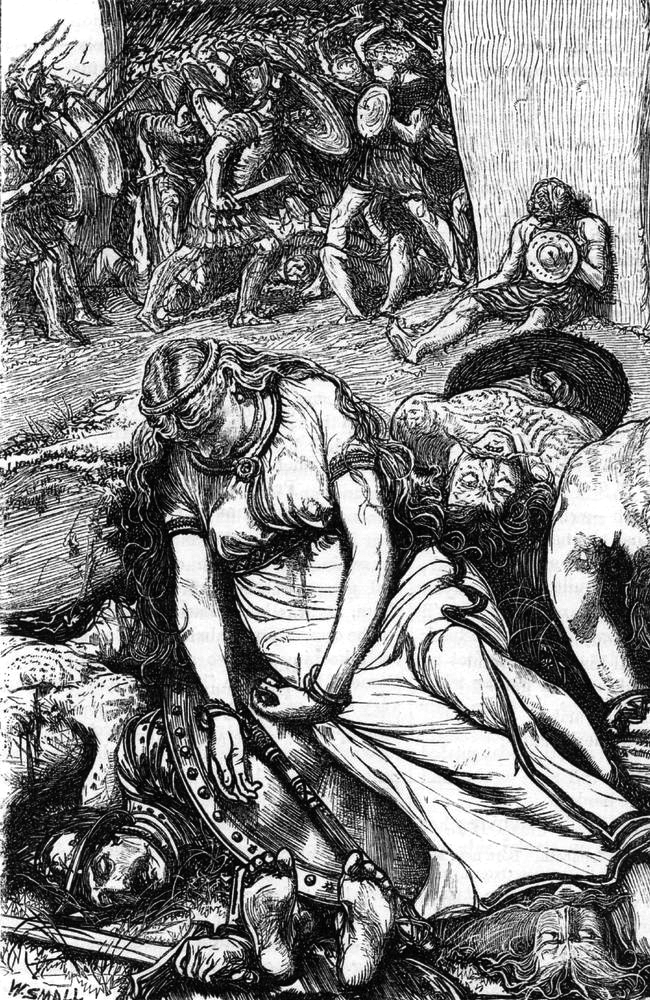
When Poenius Postumus learnt of the victory, his earlier refusal to obey orders and join Suetonius led him to fall on his own sword. No reason is offered for his conduct and it is possible that he had acted out of caution, reluctant to leave the west unguarded, rather than playing the coward. After all, as a former primus pilus, the man must have been a well seasoned soldier.
The legion itself must have hung its head in shame and it remained plain old II Augusta till the end of its days. Conversely, legio XIIII Gemina became Nero’s favourite, who declared its members ‘best of all’ (Tacitus Historiae 2.11.2), and gained the titles Martia Victrix (ILS 2648), while legio XX gained the titles Valeria Victrix (RIB 508, ILS 9200).
As for Suetonius, he was hailed as the greatest general of his day.
Romans Take revenge on the Iceni and Trinovantes
The whole might of the Roman army was now concentrated against the Iceni and Trinovantes, and their territory was laid waste by fire and the sword. To make good Roman casualties, reinforcements of two thousand legionaries, eight auxiliary infantry cohorts and two auxiliary cavalry regiments were sent from Germany. The rebels had not sown a crop that year because they were confident of victory, and a dire famine followed their defeat.
Military Occupation of the Iceni and Trinovantes lands
Little is known of the military bases in Essex and East Anglia that crushed the revolt. In Essex one of the two forts suspected at Chelmsford is presumably Boudican; a larger base at Great Chesterford played a still more important role. There was a fort built in Suffolk at Ixworth / Pakenham, occupying 10 acres and probably built in response to the Boudiccan revolt and was only in use till the end of the 1st century AD.
Another site which has produced a significant crop-mark is by the Roman settlement of Coddenham (Combretovium) (Baylham House) on the road from Camulodunum, leading due north towards Caistor, the tribal capital of the Iceni.
In the immediate post-Boudican phase was the construction of the military installation at the Lunt, Baginton, just outside Coventry. The fort was built just after the Boudican uprising probably as a campaign headquarters and supply base for the Roman army. It was only occupied for about 20 years between 60-80AD, and was constructed of timber, earth and turf. Its numerous granaries suggest its use as a food depot not only for its own troops but also for others stationed nearby. One interesting feature of the fort is the presence of a large circular structure, about 36 metres in diameter, which has been interpreted as a cavalry training ring. Possibly specifically for the training of horses confiscated from the Iceni.
Impact on the Civilian Settlements
There are signs of the impact of the revolt on Icenian and Trinovantian settlements in rural Norfolk and Suffolk, although nothing yet that is comparable to the burnt destruction layers at the towns destroyed by Boudica.
At West Stow in Suffolk, on the edge of the tract of sandy country-side called the Breckland, there was an Icenian farmstead occupied until the mid first century AD. The settlement consisted of round houses, distinguished by their irregular plans. Brooches show occupation continued until c.AD 40-60. No pre-Boudican Roman pottery or coins were recovered from the site. The site was abandoned after the middle of the century and it is tempting to connect this with the revolt. But there is no destruction horizon at West Stow and presumably the inhabitants had left the site in the revolt, never to return, or had starved to death in its aftermath. Occupation did not resume until after c.AD70 and within ten years an important pottery industry had emerged on the site.
A Trinovantian site that may have suffered in the revolt was Burgh-by-Woodbridge, Suffolk. It was a rectangular enclosure defended by a double ditch and rampart built in the first century BC. Just before the Roman invasion a smaller defended enclosure was built inside the main defences. About AD 60 part of these inner defences was destroyed. Two finds of unstratified Roman military equipment — an artillery bolt and a bent (and therefore used) javelin head — point to an attack on the site. If Burgh was not attacked in AD 43, it too may have been a casualty of the Boudican revolt.
The high-status ‘city’ settlement at Sedgeford in north-west Norfolk was abandoned within at most a decade of the Boudican Rebellion: the archaeological record here simply stops. Did the Icenian inhabitants flee, were massacred or were forcibly dispossessed of their ancestral territory. The burnt roundhouse would fit with theories of Roman military violence.
The great ceremonial and religious complex at Thetford, Norfolk, is another site in East Anglia where the stern hand of Rome is evident. After the revolt the site was abandoned and it saw no resumption of activity for two hundred years. Its end was dramatic, although a lack of burnt daub from its buildings shows there was no destruction by fire. Instead the site experienced a systematic and relentless demolition. Excavation revealed little sign of rotted timber in its many postholes and post settings. Instead the larger post settings had ramps or pits cut into the ground alongside them for their removal. Smaller postholes were often oval where the posts had been rocked backwards and forwards to loosen them before extraction. Ditches were at least partially backfilled with rampart material. Scattered across the site were five pieces of Roman military equipment, suggesting the presence of the army: after the revolt, a detachment of Roman soldiers had descended on Thetford and obliterated it.
